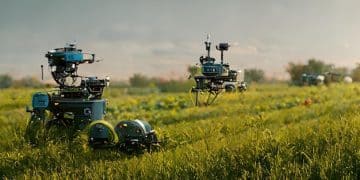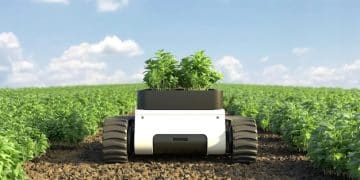Robotic Harvesting: Solving Labor Shortages and Boosting Farm Efficiency
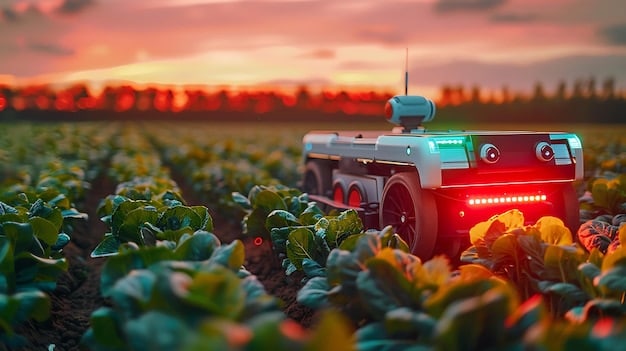
Robotic harvesting offers a promising solution to labor shortages in agriculture and can significantly improve efficiency by automating tasks, reducing costs, and increasing yields, potentially boosting efficiency by as much as 40%.
The agricultural sector has long faced challenges related to labor availability and efficiency. Robotic harvesting: Can it solve labor shortages and improve efficiency by 40%? This question looms large as technological advancements bring increasingly sophisticated robots to the fields, promising to reshape traditional farming practices.
The Looming Labor Crisis in Agriculture
Agriculture, a cornerstone of global economies, is facing a severe labor shortage. Understanding the factors contributing to this crisis is crucial to appreciating the potential impact of robotic harvesting.
Several factors have converged to create this perfect storm. Declining interest in manual labor, coupled with stringent immigration policies and an aging workforce, has left many farms struggling to find enough hands to harvest their crops.
The Impact of Labor Shortages on Farms
Labor shortages directly impact farms’ bottom lines, leading to unharvested crops, reduced planting, and increased costs. This can have cascading effects on food prices and availability.
Economic Consequences of Unharvested Crops
When crops are left unharvested due to a lack of labor, it’s not just farmers who suffer. The entire supply chain, from processors to retailers, feels the pinch. Consumers may face higher prices and limited access to certain produce.
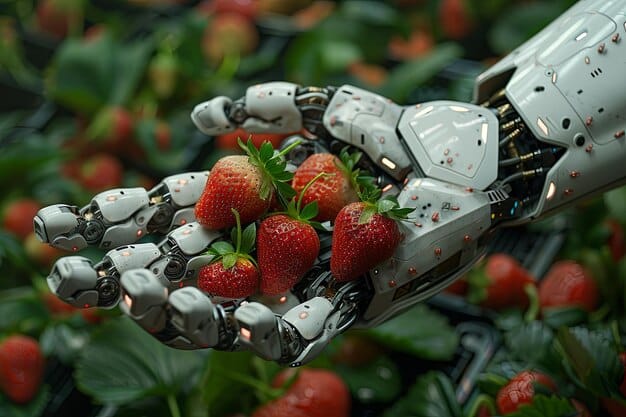
The economic consequences are significant, underlining the urgent need for innovative solutions like robotic harvesting.
- Rising food prices due to decreased supply.
- Lost revenue for farmers and related industries.
- Increased reliance on imports from countries with lower labor costs.
The need to address these issues is paramount for ensuring food security and economic stability.
Robotic harvesting presents a viable alternative by automating labor-intensive tasks, potentially mitigating these negative impacts.
How Robotic Harvesting Works
Robotic harvesting is more than just putting robots in fields; it’s a complex integration of advanced technologies designed to mimic and improve upon human harvesting capabilities.
These robots rely on cutting-edge systems, including computer vision, artificial intelligence, and precision robotics, to identify, select, and harvest crops with minimal damage and maximum efficiency.
The Role of Computer Vision and AI
Computer vision allows robots to “see” the environment, differentiating ripe produce from unripe ones, weeds, and other obstacles. AI algorithms enable them to make intelligent decisions in real time.
Precision Robotics and Gentle Handling
The use of advanced robotic arms and grippers ensures that crops are handled gently, minimizing bruising and damage that can lead to spoilage. This precision is essential for maintaining the quality of harvested produce.
The combination of these technologies allows robots to work tirelessly and accurately.
- Computer vision identifies ripe crops.
- AI makes harvesting decisions.
- Robotic arms gently pick produce.
This holistic approach to harvesting promises better results and less waste.
By emulating and improving human capabilities, robotic harvesting systems offer a viable solution to labor shortages and can potentially boost farm efficiency.
Efficiency Gains with Robotic Harvesting: The 40% Promise
One of the most compelling arguments for robotic harvesting is its potential to increase efficiency. The claim that it can boost efficiency by 40% is attracting significant attention.
This figure is based on studies and real-world deployments that demonstrate the ability of robots to work longer hours, reduce waste, and optimize harvesting schedules.
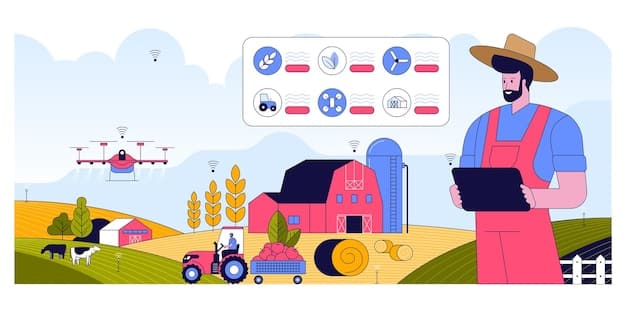
Real-World Examples of Efficiency Improvements
Several farms have already implemented robotic harvesting systems and are reporting significant efficiency gains. These examples provide concrete evidence of the potential benefits.
Data-Driven Harvesting and Optimized Schedules
Robots can collect data on crop yields, ripeness, and other factors, allowing farmers to make more informed decisions about when and where to harvest. This data-driven approach optimizes schedules and reduces waste.
Analyzing the data, optimizing schedules, and reducing waste leads to increased output and decreased costs.
- Increased speed due to round-the-clock operation.
- Reduced waste through precise selection and handling.
- Optimized scheduling based on real-time data.
These benefits contribute to the 40% efficiency boost.
The efficiency gains are not just theoretical; real-world examples and data-driven insights support the promise of robotic harvesting, making it an attractive solution for farmers.
Overcoming the Initial Investment: Cost-Benefit Analysis
While the benefits of robotic harvesting are evident, the initial investment can be a barrier for many farmers. A thorough cost-benefit analysis is essential to understanding the long-term economic viability of these systems.
Factors such as the cost of robots, maintenance, and integration with existing farm infrastructure must be weighed against the potential savings in labor costs, reduced waste, and increased yields.
Calculating ROI: Factors to Consider
Calculating the return on investment (ROI) requires a comprehensive understanding of the costs and benefits. This includes considering the lifespan of the robots, their maintenance requirements, and the potential for increased revenue.
Government Incentives and Grants
Many governments are offering incentives and grants to encourage the adoption of agricultural technologies, including robotic harvesting. These incentives can significantly reduce the initial investment and make the technology more accessible to farmers.
Considering the incentives and grants can drastically impact the ROI.
- Initial cost of robots and infrastructure.
- Maintenance and operational expenses.
- Labor cost savings and increased yields.
By considering all these factors, farmers can make informed decisions about investing in robotic harvesting.
A comprehensive cost-benefit analysis, coupled with government incentives, can make robotic harvesting a financially sound investment for farmers looking to overcome labor shortages and improve efficiency.
Challenges and Limitations of Robotic Harvesting
Despite the promise of robotic harvesting, it’s important to acknowledge the challenges and limitations that still exist. Addressing these obstacles is crucial to the successful widespread adoption of this technology.
Technical challenges, such as the ability to handle diverse crops and navigate complex terrain, as well as social and ethical concerns, must be taken into account.
Technical Hurdles: Crop Diversity and Terrain Navigation
Robots are not yet capable of harvesting all types of crops. Adapting to different shapes, sizes, and growing conditions requires significant advancements in computer vision and robotics.
Navigating uneven terrain and avoiding obstacles in the fields can also be challenging. Robots need to be robust and adaptable to operate effectively.
Social and Ethical Considerations: Job Displacement
The potential for job displacement is a significant concern. As robots take over harvesting tasks, it’s essential to address the impact on farmworkers and provide opportunities for retraining and alternative employment.
The ethical considerations need to be addressed for societal acceptance.
- Adapting to diverse crops and growing conditions.
- Navigating uneven terrain and avoiding obstacles.
- Addressing concerns about job displacement.
Taking these issues into consideration is vital.
Acknowledging and addressing these challenges is essential for ensuring the responsible and effective implementation of robotic harvesting technologies.
The Future of Farming with Robotics
The future of farming is inextricably linked to robotics. As technology continues to evolve, robots will play an increasingly important role in all aspects of agriculture, from planting to harvesting.
This transformation promises to not only address labor shortages and improve efficiency but also to create more sustainable and resilient food systems.
Integrating Robotics into the Entire Farming Cycle
Robots are already being used for tasks such as planting, weeding, and spraying. As these technologies mature, they will be integrated into a comprehensive farming cycle, optimizing every stage of production.
Sustainable and Resilient Food Systems
Robotics can contribute to more sustainable farming practices by reducing the use of pesticides and herbicides, conserving water, and minimizing soil erosion. This can lead to more resilient food systems that are better able to withstand climate change and other challenges.
Making agriculture more sustainable requires a multifaceted approach.
- Optimizing planting, weeding, and spraying.
- Reducing pesticide and herbicide use.
- Conserving water and minimizing soil erosion.
Robotic harvesting and other agricultural robots can revolutionize farming in the years to come, transforming the way food is produced and sustained.
The integration of robotics into the entire farming cycle promises a future of more sustainable, efficient, and resilient food production.
| Key Point | Brief Description |
|---|---|
| 🚜 Labor Shortages | Agriculture faces a severe shortage of manual labor. |
| 🤖 Robotic Harvesting | Automates crop harvesting using advanced technologies. |
| 📈 Efficiency Gains | Promises up to 40% efficiency increase in harvesting. |
| 💰 Cost Analysis | Requires careful evaluation of initial investment vs. long-term savings. |
FAQ Section
▼
Robotic harvesting uses advanced robots equipped with computer vision, AI, and precision robotics to automate the crop harvesting process. They can identify and pick ripe produce efficiently.
▼
By automating labor-intensive tasks, robots can reduce the reliance on human workers, addressing shortages and allowing farmers to maintain productivity despite a shrinking workforce.
▼
The primary benefits include increased efficiency, reduced waste, lower labor costs, and the ability to work longer hours, leading to greater overall productivity and profitability.
▼
Challenges include the high initial investment, technical limitations related to crop diversity and terrain navigation, and social concerns about potential job displacement among farmworkers.
▼
Robotic harvesting is expected to become more integrated into the entire farming cycle, contributing to more sustainable and resilient food systems through optimized practices and reduced resource usage.
Conclusion
Robotic harvesting is poised to revolutionize the agricultural sector by addressing critical labor shortages and enhancing operational efficiency. While challenges remain, the potential benefits – including increased yields, reduced waste, and more sustainable practices – make it a compelling solution for the future of farming. By embracing these technological advancements, the agricultural industry can ensure long-term productivity and resilience.
